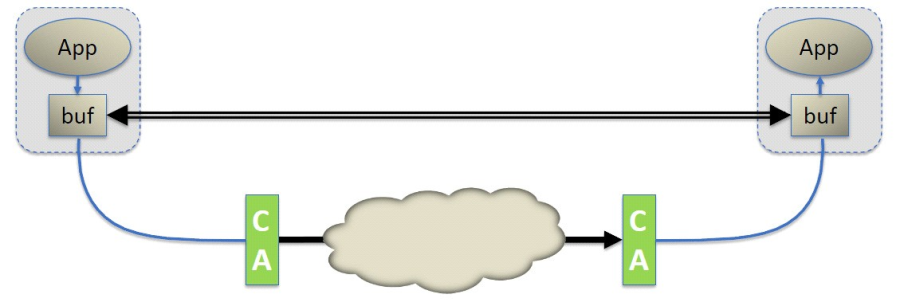Comparison of RDMA Technologies
Currently, there are three technologies that support RDMA: InfiniBand, Ethernet RoCE and Ethernet iWARP. All three technologies share a common user API which is defined in this docu- ment, but have different physical and link layers.
When it comes to the Ethernet solutions, RoCE has clear performance advantages over iWARP
— both for latency, throughput and CPU overhead. RoCE is supported by many leading solu- tions, and is incorporated within Windows Server software (as well as InfiniBand).
RDMA technologies are based on networking concepts found in a traditional network but there are differences them and their counterparts in IP networks. The key difference is that RDMA pro- vides a messaging service which applications can use to directly access the virtual memory on remote computers. The messaging service can be used for Inter Process Communication (IPC), communication with remote servers and to communicate with storage devices using Upper Layer Protocols (ULPs) such as iSCSI Extensions for RDMA (ISER) and SCSI RDMA Protocol (SRP), Storage Message Block (SMB), Samba, Lustre, ZFS and many more.
RDMA provides low latency through stack bypass and copy avoidance, reduces CPU utilization, reduces memory bandwidth bottlenecks and provides high bandwidth utilization. The key bene- fits that RDMA delivers accrue from the way that the RDMA messaging service is presented to the application and the underlying technologies used to transport and deliver those messages. RDMA provides Channel based IO. This channel allows an application using an RDMA device to directly read and write remote virtual memory.
In traditional sockets networks, applications request network resources from the operating sys- tem through an API which conducts the transaction on their behalf. However RDMA use the OS to establish a channel and then allows applications to directly exchange messages without further OS intervention. A message can be an RDMA Read, an RDMA Write operation or a Send/ Receive operation. IB and RoCE also support Multicast transmission.
The IB Link layer offers features such as a credit based flow control mechanism for congestion control. It also allows the use of Virtual Lanes (VLs) which allow simplification of the higher layer level protocols and advanced Quality of Service. It guarantees strong ordering within the VL along a given path. The IB Transport layer provides reliability and delivery guarantees.
The Network Layer used by IB has features which make it simple to transport messages directly between applications' virtual memory even if the applications are physically located on different servers. Thus the combination of IB Transport layer with the Software Transport Interface is bet- ter thought of as a RDMA message transport service. The entire stack, including the Software Transport Interface comprises the IB messaging service.

The most important point is that every application has direct access to the virtual memory of devices in the fabric. This means that applications do not need to make requests to an operating system to transfer messages. Contrast this with the traditional network environment where the shared network resources are owned by the operating system and cannot be accessed by a user application. Thus, an application must rely on the involvement of the operating system to move data from the application's virtual buffer space, through the network stack and out onto the wire. Similarly, at the other end, an application must rely on the operating system to retrieve the data on the wire on its behalf and place it in its virtual buffer space.

TCP/IP/Ethernet is a byte-stream oriented transport for passing bytes of information between sockets applications. TCP/IP is lossy by design but implements a reliability scheme using the Transmission Control Protocol (TCP). TCP/IP requires Operating System (OS) intervention for every operation which includes buffer copying on both ends of the wire. In a byte stream-ori-
ented network, the idea of a message boundary is lost. When an application wants to send a packet, the OS places the bytes into an anonymous buffer in main memory belonging to the oper- ating system and when the byte transfer is complete, the OS copies the data in its buffer into the receive buffer of the application. This process is repeated each time a packet arrives until the entire byte stream is received. TCP is responsible for retransmitting any lost packets due to con- gestion.
In IB, a complete message is delivered directly to an application. Once an application has requested transport of an RDMA Read or Write, the IB hardware segments the outbound mes- sage as needed into packets whose size is determined by the fabric path maximum transfer unit. These packets are transmitted through the IB network and delivered directly into the receiving application's virtual buffer where they are re-assembled into a complete message. The receiving application is notified once the entire message has been received. Thus neither the sending nor the receiving application is involved until the entire message is delivered into the receiving appli- cation's buffer.